The founding of the 20th century conservative movement: The restoration of traditionalism
A short history of conservatism: Part 11
Fred Hutchison, RenewAmerica analyst
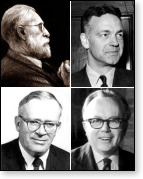 Originally published March 17, 2008
Originally published March 17, 2008
The birth of the conservative intellectual movement in the 1940's happened at about the same time that the nihilistic philosophy of atheistic Existentialism came to American shores. While Sartre was sitting in a coffee shop in Paris writing Being and Nothingness and ignoring the Nazi occupation, four great thinkers were laying the foundations for a renewal of Traditionalist Conservatism in the West. While the Existentialists were saying that man is empty and alone in an absurd world, the four conservative pioneers were saying that Western man has a rich cultural and spiritual heritage to draw upon to renew himself.
This essay will cover the restoration of Traditionalist Conservatism. The five kinds of conservatism spawned by that restoration are summarized below. They are listed in the sequence of their twentieth-century restoration.
The five stages of development of the postwar conservative movement
Conservatism is ancient precisely because it is inherent to human nature. Strains of Western Traditionalism go back to 800 B.C. In contrast, liberalism-modernism-progressivism is historically recent, and puts forward false views about human nature. Therefore, the eventual failure of liberalism and the restoration of conservatism is inevitable.
The five stages of development of 20th century conservatism listed below are five restorations. All five restorations began with intellectual writers who deal in ideas.
1) Traditionalism: The intellectual foundations of Traditionalist Conservatism were laid by Christopher Dawson, Robert Hutchins, Richard Weaver, and Russell Kirk. The formulation of intellectual Traditionalism was developed over several decades, but the foundations were essentially laid and the intellectual movement had a significant band of adherents by the late 1940's. In this essay, we shall consider the three main kinds of Traditionalist Conservatism.
2) Libertarianism: American Libertarianism originated with the Classical Liberalism of the American founders. Classical Liberalism was a synthesis of classical economics and Natural Law theory. It provided us with some of our cherished conceptions of a free Republic.
Modern Libertarianism has retained some of its Classical Liberal traits and has drifted away from others. Libertarianism has many permutations, but the three main branches that emerged in the Libertarian rebellion of the 40's will be considered in this essay.
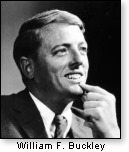 In the next essay, I shall introduce the grand synthesis of Traditionalist Conservatism and Libertarianism engineered by William F. Buckley Jr. in the 50's and by Barry Goldwater and Phyllis Schlafly in the 60's. I shall also allude to Buckley's role in drawing conservative Catholics into politics.
In the next essay, I shall introduce the grand synthesis of Traditionalist Conservatism and Libertarianism engineered by William F. Buckley Jr. in the 50's and by Barry Goldwater and Phyllis Schlafly in the 60's. I shall also allude to Buckley's role in drawing conservative Catholics into politics.
3) Christian conservatism: The synthesis of Christianity and Traditionalist Conservatism was intellectually developed by Christopher Dawson and Richard Weaver in stage one noted above. This synthesis provided a rationale for Evangelicals and conservative Catholics to enter politics in 1980 and to vote for Ronald Reagan. However, the actual motive of the Christian right for entering politics was to correct the moral decadence of the nation.
As a grand finale at the end of this series, we shall trace the epic journey of Christian theological and cultural traditionalism. We shall start the journey in the Patristic Age and navigate through the Gothic Age, the Baroque Age, and the Romantic Age.
4) Neoconservatism: The complicated and fascinating genesis of Neoconservatism will be summarized in a future essay and will include the role played by Robert Hutchins and Mortimer Adler in stage one, along with Leo Strauss, Irving Kristal, and Norman Podhoretz. As you may have guessed, Buckley played a role in this process by offering the microphone and print space to friendly Neocon intellectuals.
The Neoconservative contributions to the restoration of American literary culture and to the foreign policy of President George W. Bush will be briefly enumerated.
5) Natural Law philosophy, which guided the American founders, has a proven value for constitutional law in the late 20th century. Natural Law philosophy has a potential value for providing a framework for restoring the American Republic according to the principles of the founders. As a political philosophy, Natural Law can provide a rationale and a guide to political action in a constitutional context.
Natural Law philosophy is able to draw Libertarians back from the extremes to which some of them have drifted. The Natural Law lighthouse summons the Libertarian to return from the stormy seas of hyper-individualism to his true home of Classical Liberalism. There he shall find safe haven at the home port of the American conservative movement.
Four giants
Now let us consider the four great men who restored the Traditionalist intellectual movement and got the 20th century conservative movement rolling. While Sartre sat in his sidewalk café, watching the Nazi storm troopers march by and scribbling his nihilistic counsels of despair, four great men were laying the groundwork for the restoration of Western civilization. These are the founding fathers of the 20th century conservative movement. We are grateful dwarfs who are privileged to sit upon the shoulders of these giants.
Christopher Dawson
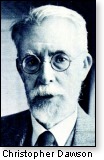 Christopher Dawson (1889–1970), an English scholar, was a young Anglo-Catholic who converted to Roman Catholicism. He was nine years older than C.S. Lewis, who was also an Anglo-Catholic (and who briefly considered converting to Catholicism, but decided against it.)
Christopher Dawson (1889–1970), an English scholar, was a young Anglo-Catholic who converted to Roman Catholicism. He was nine years older than C.S. Lewis, who was also an Anglo-Catholic (and who briefly considered converting to Catholicism, but decided against it.)
Both Dawson and Lewis were Medievalists and Renaissance men. Dawson's focus was history, theology, and culture, and Lewis concentrated on literature. Dawson, an Anglo-Saxon scholar, was essentially an intellectual with a philosophic bent, while Lewis, a lyrical Celt from Ulster, was deeply immersed in the humane letters.
Dawson originally set out to write a theory of history as did Spengler and Toynbee. Arnold Toynbee was four years older than Dawson and was a denizen of Oxford like Lewis.
Dawson's studies of theories of history provided an intellectual foundation for his future works. However, his life work was mainly focused upon the history of Western culture and the role of religion in the formation, inspiration, and preservation of culture.
His essay on the six ages of the church, involving three stages within each age, reveal that he never entirely lost interest in theories of history. I will borrow heavily from Dawson in my essay about the four ages of Christian traditionalism – which will be the final installment in this series. Like many writers before me, I am like a dwarf sitting upon the broad shoulders of the giant Dawson – and am seeing distant vistas from the vantage point of his great height.
Religion and culture
Dawson wrote: "It is the religious force which supplies the cohesive force which unifies a society and a culture.... [A] society which has lost its religion becomes sooner or later a society which has lost its culture."
Clearly, the decline of Western culture is related to the decline of Christianity after 1750. In the 20th century, when the separation of church and state was taken to mean that the Christian faith is to be hermitically sealed off from the general culture, the cultural decline accelerated.
Spiritual aspirations emanating from religious faith enlarge the heart, expand the imagination, and awaken and inspire the verbal, lyrical, and intellectual faculties. Men who are thus vivified are often overflowing with ideals, thoughts, and sentiments, which must be channeled through cultural outlets to find expression. In this manner, the prevailing religious faith of a society gives birth to that society's culture and inspires and sustains that culture. The high culture of European civilization prior to 1750 is a tribute to the powerful spiritual aspirations engendered by Christian spirituality.
In painful contrast, some of our present Evangelical megachurches, which are seeker-sensitive entertainment centers, seem to be more influenced by the contemporary culture than the culture is influenced by them. This captivity of the church by the culture happens when a shallow and watery spirituality proves to be incapable of engendering the kind soaring aspirations that can change a culture.
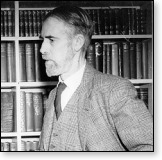 Dawson was every bit as much a Christian Conservative as he was a Traditionalist Conservative. Traditionalist thinkers are drawn to cultural history – and Western cultural history prior to 1750 is permeated with Christian influences. That is why Traditionalist Conservatism is compatible with Christianity.
Dawson was every bit as much a Christian Conservative as he was a Traditionalist Conservative. Traditionalist thinkers are drawn to cultural history – and Western cultural history prior to 1750 is permeated with Christian influences. That is why Traditionalist Conservatism is compatible with Christianity.
The archenemy of modernism
Dawson called for the recovery of the Medieval worldview in which the rationality, freedom, and moral effort of the individual were of central importance. He was horrified by the specter of modern individuals being swallowed up into a collective. Therefore, he occasionally sounded like a Libertarian inveighing against identity politics.
The nihilistic (existentialist) and positivistic spirit of the age were anathema to Dawson. "Positivism" = negativism, in the sense that the Positivists skeptically reject everything that cannot be proven by observation and material proof.
Dawson also rejected the Modernist cult of "progress." Modernists turned their backs on the golden cultural heritage of the West and returned to cultural barbarism in the name of "progress." For example, Picasso stopped painting stylized Harlequins and clowns when he saw a tribal African mask. His art quickly disintegrated into ugly fragments. His abominations on canvas are highly valued by our barbarous culture.
As we shall see, all five kinds of conservatism have an essential role to play in the fight against Modernism and Postmodernism. However, it was that great Christian Traditionalist Christopher Dawson who sounded the alarm about our common enemy and did so in a historically, spiritually, and intellectually satisfying way. It was the prescient Dawson, a Christian intellectual, who first summoned us to the culture war.
 Robert Hutchins
Robert Hutchins
Robert Maynard Hutchins (1899–1997) was the president of the University of Chicago from 1929–1948. He was the editor of Great Books of the Western World and Gateway to the Great Books.
Hutchins came from a line of Presbyterian ministers, but became a secular "perennialist." As a perennialist, he held that we should teach the things of everlasting value to all people everywhere. He converted from legal realism to metaphysical philosophy while studying Neoscholastic philosophy in which Aristotle and Saint Thomas Aquinas played a central role. Metaphysics deals with ideas that are universal, immutable, and everlasting.
After Hume's skepticism and Kant's withering critique in the late 18th century, metaphysicians wandered in the wilderness for a century. The exile of metaphysics resulted in an increasing divorce from reason, reality, and morality in the West and a loss of transcendent aspirations. A Neoscholastic revival during the Victorian Era restored metaphysics to the West for a season. As a college student, Hutchins lived in the academic afterglow of this "Thomist" revival. His awakening to metaphysical rationality was the basis for the great contributions he subsequently made to Western culture.
Hutchins promulgated the idea of the "great ideas" and the "great conservation." According to Hutchins, a set of great ideas has been enthusiastically discussed by Western thinkers in every generation from Homer to Hemingway. These ideas have an everlasting quality because men in every generation and every place are interested in them. This is where Hutchins' perennialist philosophy came into play.
Hutchins' younger colleague Mortimer Adler identified 102 great ideas, and Hutchins' committee identified 130 great Western thinkers and writers. Adler's Synopticon summarizes what these great thinkers said about each of the great ideas.
According to Hutchins, every great Western thinker and writer has wrestled with and been inspired by what previous great thinkers and writers said about the great ideas. He called this "the great conversation" because each generation of leading thinkers and writers behaved as though they were sitting around a table discussing and debating the great ideas with the immortal thinkers and writers who had gone before. The great conversation is an indispensable idea for Traditionalist Conservative thinkers and for Neoconservatives.
The great ideas make us more rational because they fill our minds with a large inventory of expansive ideas that provoke rational discussion and reflection. Musing on the great ideas can gradually turn a bright young barbarian into a rational and civilized man.
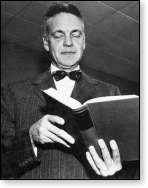 Hutchins proved that the great ideas are exciting to modern college students. Slumbering students are capable of awakening from the intellectual anesthesia of Modernism and becoming earnest bibliophiles as they gather with alacrity around the discussion table where the great ideas are discussed.
Hutchins proved that the great ideas are exciting to modern college students. Slumbering students are capable of awakening from the intellectual anesthesia of Modernism and becoming earnest bibliophiles as they gather with alacrity around the discussion table where the great ideas are discussed.
Hutchins was an archetypal traditionalist because he gathered together the best of Western thought from the Classical, Medieval, Early Modern, and Modern eras. He was a conservative because he wanted to conserve and preserve the intellectual culture in which the great ideas are regularly discussed.
When Hutchins came on the scene, the great conversation was flagging. For the first time in 2,800 years, a cleavage had opened up between the best contemporary writers and the great conversation. Modernists had succeeded in cutting Western writers off from their intellectual and literary heritage. Hutchins got the great conversation cranked up and going again. As such, he is a hero of Western culture. In a sane world, statues should be erected to his memory on the public square.
A conservatism centered on ideas
Hutchins ensured that the incipient conservative movement would be about ideas. Conservative debaters often have a grasp of ideas that is superior to their liberal opponents, partially because some leading conservatives were exposed to Hutchins' Great Books program. Conservative jurist Robert Bork went to the University of Chicago in order to become an intellectual. Alan Keyes studied political philosophy under Allan Bloom, who was deeply influenced by the Great Books program. Bork and Keyes have exceptional skills as debaters.
Great books discussion groups have created a debate culture among conservatives who sharpen their wits in debates with each other. In contrast, debate about ideas is blocked in liberal circles by group-think, multiculturalism, codes of political correctness, and identity politics.
The Jewish intellectual Mortimer Adler, who enumerated, cataloged, and summarized Hutchins' great ideas, seems to have been an inspiration to the younger Jewish intellectual Allan Bloom, who was Adler's colleague at the University of Chicago.
Leo Strauss, a German Jewish immigrant, was close in age to Adler, was a professor at the University of Chicago, and spoke highly of Hutchins' Great Books program.
Adler, Bloom, and Strauss were the first wave of Neoconservatives. All three were Jewish intellectuals who were disillusioned by the intellectual and aesthetic decay of the humanities in modernist academia. Irving Kristol, the leader of the second generation of Neoconservatives, transformed Neoconservatism from a literary program for Jewish intellectuals into a broad-based political movement.
Allan Bloom's critique of academia's neglect and subversion of the classics in his book The Closing of the American Mind appears to have been inspired by Hutchins' critiques of academia and Hutchins' enlightened disquisitions about the nature of education and what academia ought to be.
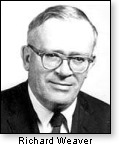 Richard Weaver
Richard Weaver
Richard Weaver (1910–1963) was a Platonist who championed transcendent truth and eschewed Nominalism. As a son of the South, he promoted agrarian ideals of the traditional values of the community. He loved the Anglican/Episcopal spirit of the Old South that honored tradition and nature.
Weaver taught English at the University of Chicago, the alma mater of Hutchins, Adler, and Bloom. Although he was, no doubt, intellectually stimulated at Chicago, his formation as a conservative intellectual seems to have occurred at an elite Southern preparatory school, at the University of Kentucky, and at Vanderbilt University in Tennessee.
In his famous book Ideas have Consequences (1948), Weaver wrote that private property is the last metaphysical right of the individual. This was an indispensable idea to Traditionalist, Libertarian, and Natural Law conservatives. His idea of communitarian individualism reveals the balance between the individual and the community cherished by many conservatives.
Weaver believed that America's lamentable cultural degradation was due to the sad reality that Americans no longer believed in transcendent values and lacked the moral ambition to discover higher truth. This is inevitably the fate of a people ignorant of metaphysics. Allan Bloom reiterated this idea of Weaver in his critique of his elite students who had no interest in searching for higher truth.
The Christian gentleman
Weaver valued the old idea of a landed aristocracy. When a respected family name was linked to a tract of land for a series of generations, honor, dignity, responsibility, and stability was often the result. The traditional Western gentry produced a code of chivalry and perpetuated the idea of the Christian gentleman – an idea that goes back to the Renaissance book The Courtier (1528) by Castiglione, and to Petrarch (d. 1374), who laid the intellectual foundations for Renaissance schools for the Christian gentleman.
Weaver rejected egalitarianism and approved of the social hierarchy that placed the gentry at the summit. The pursuit of excellence by a culture produces a cultural elite. Egalitarianism produces mediocrity. The planter class of the Old South embodied the ideals of honorable Southern gentlemen. The sons of the gentry were carefully trained and brilliantly educated to become the elite leaders of their society. They all read The Courtier and attended elite schools for the Christian gentleman. Washington, Jefferson, and Madison were sterling products of this culture of the agrarian gentry.
Paleoconservatism
Weaver's intellectual followers split into the Paleoconservatives and Agrarian Conservatives. Paleoconservatives (sometimes called "classical conservatives") are anticommunists and champion America-first ideas. Paleocons stress tradition, civil society, and classical federalism. They seek to find their identity in family roots, religious tradition, community, regional traits and customs, patriotism, and European culture. Theirs is a culture of sanctified memory. When Paleocons research their cultural roots, they often look back to Anglo-Saxon and Scots-Irish Americana. Some Paleocons are unabashed nativists.
Paleocons differ from Neocons on immigration, international trade, affirmative action, foreign wars, international associations, and the welfare state. The anti-authoritarian tendencies of populist Paleocons are contrary to the hierarchicalism of Weaver and represent a tidbit borrowed from Buckley and Goldwater's synthesis of Traditionalism and Libertarianism. However, in the age of Rush Limbaugh, when paleocon radio talk-show hosts despise the liberal elite, populist Paleoconservatism has more political traction than does the appeal of Weaver's elitist hierarchy.
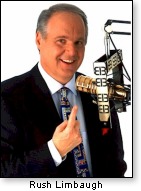 Paleocons and Agrarians are the heirs of the blood and soil romantics of the Old South, except that Paleocons emphasize blood and Agrarians emphasize soil.
Paleocons and Agrarians are the heirs of the blood and soil romantics of the Old South, except that Paleocons emphasize blood and Agrarians emphasize soil.
Paleocons of an "America first" mindset sometimes reject the military culture and imperial expansionism of the Old South. However, family military traditions remain strong in many parts of the South. Hunting and gun ownership are an integral part of this culture. After all, hunting and soldiering were favored vocations of the Southern gentry.
John Kerry might have lost the presidential election of 2004 because of his gun-control policy. Some Democrats who are avid hunters turned against him and may have deprived him of the electoral votes of Iowa, New Mexico, and Ohio, and almost cost him Pennsylvania and Michigan.
Both Paleocons and Agrarians advocate states' rights, as did the Old South. Therefore, they join hands with Natural Law conservatives on issues of federalism.
Senator Robert Taft of Ohio, who ran for president in 1952, was the first Paleocon with national political traction. His Conservative Coalition included conservative Republicans in the North and conservative Democrats in the South. Rush Limbaugh and Pat Buchanan are the two most politically influential Paleocons of the present generation.
Agrarians
Agrarians are more likely to have Southern roots and sympathies and nostalgic memories of rural life than are Paleocons – and they are more likely to be hunters. As their name implies, Agrarians are interested in Weaver's description of the virtues of staying close to the land. Agrarian men aspire to be Southern gentlemen with honor, chivalry, courtesy, and hospitality.
The ideal of a Southern landed gentry whose families have lived for generations on the same piece of land has faded a bit due to the decline of family farms and the restlessness and wanderlust of young folks raised in the country. However, the ideal of agrarian writers and poets who stay close to the soil has flourished and spread from the South to the Midwest plains.
Last summer, I met a lady poet on a small farm in Iowa. Sinking her feet into the rich soil of an Iowa farm inspires her poems. Like Scarlett O'Hara, she seemed to draw her strength from the land.
She reminds me of the words of Gerald O'Hara to Scarlett in Gone With the Wind: "Why, land is the only thing in the world worth working for, because it is the only thing that lasts.... It will come to you, this love of the land. There is no getting around it if you're Irish." Notice how O'Hara's agrarian love of the land is mingled with his love of his family's Celtic blood lines. On the O'Hara plantation, nativist ideals of blood were freely mingled with romantic ideas about a folk culture that rises from the soil.
Russell Kirk
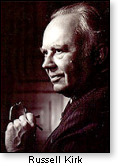 Russell Kirk (1918–1994) was an American political theorist, historian, social critic, and literary critic. He gleaned his ideas from great works of literary fiction and from the ideas, words, and actions of great statesmen. His formation as a conservative was not through Christianity like Dawson, or through metaphysics like Hutchins, or through blood and soil traditions and ideals like Weaver. Kirk's formation came through literature and histories with literary value and leaders about whom we can tell stories in literary form.
Russell Kirk (1918–1994) was an American political theorist, historian, social critic, and literary critic. He gleaned his ideas from great works of literary fiction and from the ideas, words, and actions of great statesmen. His formation as a conservative was not through Christianity like Dawson, or through metaphysics like Hutchins, or through blood and soil traditions and ideals like Weaver. Kirk's formation came through literature and histories with literary value and leaders about whom we can tell stories in literary form.
Although Kirk became a well-known writer much later than Weaver, he developed a tremendous following as a writer for Buckley's magazine, National Review. Buckley, as an agile Irish raconteur and literary buff, preferred lyrical writers from the humane letters like Kirk and C.S. Lewis over heavy intellectual-philosophic types like Toynbee, Dawson, and Hutchins.
Indeed, Kirk's histories sometimes read like epic tales. In a different age, he might have been a bard like Homer or Ossian, the legendary Scottish bard. Kirk's version of Traditionalist Conservatism overlaps with Weaver's conservatism. Kirk had Scottish roots, and in the Celtic world, the bards were typically aligned with clan chiefs who valued blood and soil traditions. These folk ideals were grafted into the culture of the Old South.
Kirk had a formative influence upon some Paleocons, and, like Weaver, was inspired by Edmund Burke to preserve the "social fabric" that embodies the accumulated wisdom of many generations.
Kirk had a facility for colorful historical narratives in which he described the development of the social fabric. He was particularly astute at explaining how the English common law developed through the legal decisions of local judges over the centuries. Kirk pointed to Blackstone's Commentaries as the repository of this treasury of legal wisdom. The American founders had a profound understanding of the rights and duties of an Englishman because they read Blackstone. Constitutional scholars of the "original intent" school of thought sometimes search Blackstone to gain an understanding of what the founders meant by particular words, phrases, and passages of the Constitution.
Kirk's five overarching principles
Kirk's overarching conservative principles are:
1) A transcendent order exists that one can observe in tradition, revelation, and Natural Law.
2) The variety and mystery of human experience should be respected.
3) Society requires social classes that demarcate natural distinctions.
4) Freedom requires private property.
5) Political innovation should be prudent and compatible with existing traditions and customs.
The three main branches of traditionalist conservatism
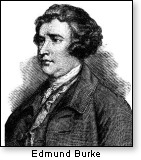 The three branches of Traditionalist conservatism are: 1) Dawson's religious and historically based cultural conservatism and anti-modernism, 2) Hutchins' metaphysical and literary conservatism of great ideas, and 3) Weaver-Kirk Burkean conservatism.
The three branches of Traditionalist conservatism are: 1) Dawson's religious and historically based cultural conservatism and anti-modernism, 2) Hutchins' metaphysical and literary conservatism of great ideas, and 3) Weaver-Kirk Burkean conservatism.
The Weaver-Kirk Burkean conservatism (named after Edmund Burke) can also be called "social fabric" conservatism. In different ways, Weaver and Kirk wanted to preserve the social fabric from the depredations of Modernism. The three branches of Weaver-Kirk Burkeans are Paleocons, Agrarians, and the intellectual heirs of Kirk.
Stay tuned for the drama of the Libertarian rebellion in the next essay.
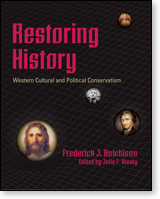 A message from Stephen Stone, President, RenewAmerica
A message from Stephen Stone, President, RenewAmerica
I first became acquainted with Fred Hutchison in December 2003, when he contacted me about an article he was interested in writing for RenewAmerica about Alan Keyes. From that auspicious moment until God took him a little more than six years later, we published over 200 of Fred's incomparable essays — usually on some vital aspect of the modern "culture war," written with wit and disarming logic from Fred's brilliant perspective of history, philosophy, science, and scripture.
It was obvious to me from the beginning that Fred was in a class by himself among American conservative writers, and I was honored to feature his insights at RA.
I greatly miss Fred, who died of a brain tumor on August 10, 2010. What a gentle — yet profoundly powerful — voice of reason and godly truth! I'm delighted to see his remarkable essays on the history of conservatism brought together in a masterfully-edited volume by Julie Klusty. Restoring History is a wonderful tribute to a truly great man.
The book is available at Amazon.com.
© Fred Hutchison
November 22, 2013
 Originally published March 17, 2008
Originally published March 17, 2008The birth of the conservative intellectual movement in the 1940's happened at about the same time that the nihilistic philosophy of atheistic Existentialism came to American shores. While Sartre was sitting in a coffee shop in Paris writing Being and Nothingness and ignoring the Nazi occupation, four great thinkers were laying the foundations for a renewal of Traditionalist Conservatism in the West. While the Existentialists were saying that man is empty and alone in an absurd world, the four conservative pioneers were saying that Western man has a rich cultural and spiritual heritage to draw upon to renew himself.
This essay will cover the restoration of Traditionalist Conservatism. The five kinds of conservatism spawned by that restoration are summarized below. They are listed in the sequence of their twentieth-century restoration.
The five stages of development of the postwar conservative movement
Conservatism is ancient precisely because it is inherent to human nature. Strains of Western Traditionalism go back to 800 B.C. In contrast, liberalism-modernism-progressivism is historically recent, and puts forward false views about human nature. Therefore, the eventual failure of liberalism and the restoration of conservatism is inevitable.
The five stages of development of 20th century conservatism listed below are five restorations. All five restorations began with intellectual writers who deal in ideas.
1) Traditionalism: The intellectual foundations of Traditionalist Conservatism were laid by Christopher Dawson, Robert Hutchins, Richard Weaver, and Russell Kirk. The formulation of intellectual Traditionalism was developed over several decades, but the foundations were essentially laid and the intellectual movement had a significant band of adherents by the late 1940's. In this essay, we shall consider the three main kinds of Traditionalist Conservatism.
2) Libertarianism: American Libertarianism originated with the Classical Liberalism of the American founders. Classical Liberalism was a synthesis of classical economics and Natural Law theory. It provided us with some of our cherished conceptions of a free Republic.
Modern Libertarianism has retained some of its Classical Liberal traits and has drifted away from others. Libertarianism has many permutations, but the three main branches that emerged in the Libertarian rebellion of the 40's will be considered in this essay.
 In the next essay, I shall introduce the grand synthesis of Traditionalist Conservatism and Libertarianism engineered by William F. Buckley Jr. in the 50's and by Barry Goldwater and Phyllis Schlafly in the 60's. I shall also allude to Buckley's role in drawing conservative Catholics into politics.
In the next essay, I shall introduce the grand synthesis of Traditionalist Conservatism and Libertarianism engineered by William F. Buckley Jr. in the 50's and by Barry Goldwater and Phyllis Schlafly in the 60's. I shall also allude to Buckley's role in drawing conservative Catholics into politics.3) Christian conservatism: The synthesis of Christianity and Traditionalist Conservatism was intellectually developed by Christopher Dawson and Richard Weaver in stage one noted above. This synthesis provided a rationale for Evangelicals and conservative Catholics to enter politics in 1980 and to vote for Ronald Reagan. However, the actual motive of the Christian right for entering politics was to correct the moral decadence of the nation.
As a grand finale at the end of this series, we shall trace the epic journey of Christian theological and cultural traditionalism. We shall start the journey in the Patristic Age and navigate through the Gothic Age, the Baroque Age, and the Romantic Age.
4) Neoconservatism: The complicated and fascinating genesis of Neoconservatism will be summarized in a future essay and will include the role played by Robert Hutchins and Mortimer Adler in stage one, along with Leo Strauss, Irving Kristal, and Norman Podhoretz. As you may have guessed, Buckley played a role in this process by offering the microphone and print space to friendly Neocon intellectuals.
The Neoconservative contributions to the restoration of American literary culture and to the foreign policy of President George W. Bush will be briefly enumerated.
5) Natural Law philosophy, which guided the American founders, has a proven value for constitutional law in the late 20th century. Natural Law philosophy has a potential value for providing a framework for restoring the American Republic according to the principles of the founders. As a political philosophy, Natural Law can provide a rationale and a guide to political action in a constitutional context.
Natural Law philosophy is able to draw Libertarians back from the extremes to which some of them have drifted. The Natural Law lighthouse summons the Libertarian to return from the stormy seas of hyper-individualism to his true home of Classical Liberalism. There he shall find safe haven at the home port of the American conservative movement.
Four giants
Now let us consider the four great men who restored the Traditionalist intellectual movement and got the 20th century conservative movement rolling. While Sartre sat in his sidewalk café, watching the Nazi storm troopers march by and scribbling his nihilistic counsels of despair, four great men were laying the groundwork for the restoration of Western civilization. These are the founding fathers of the 20th century conservative movement. We are grateful dwarfs who are privileged to sit upon the shoulders of these giants.
Christopher Dawson
 Christopher Dawson (1889–1970), an English scholar, was a young Anglo-Catholic who converted to Roman Catholicism. He was nine years older than C.S. Lewis, who was also an Anglo-Catholic (and who briefly considered converting to Catholicism, but decided against it.)
Christopher Dawson (1889–1970), an English scholar, was a young Anglo-Catholic who converted to Roman Catholicism. He was nine years older than C.S. Lewis, who was also an Anglo-Catholic (and who briefly considered converting to Catholicism, but decided against it.)Both Dawson and Lewis were Medievalists and Renaissance men. Dawson's focus was history, theology, and culture, and Lewis concentrated on literature. Dawson, an Anglo-Saxon scholar, was essentially an intellectual with a philosophic bent, while Lewis, a lyrical Celt from Ulster, was deeply immersed in the humane letters.
Dawson originally set out to write a theory of history as did Spengler and Toynbee. Arnold Toynbee was four years older than Dawson and was a denizen of Oxford like Lewis.
Dawson's studies of theories of history provided an intellectual foundation for his future works. However, his life work was mainly focused upon the history of Western culture and the role of religion in the formation, inspiration, and preservation of culture.
His essay on the six ages of the church, involving three stages within each age, reveal that he never entirely lost interest in theories of history. I will borrow heavily from Dawson in my essay about the four ages of Christian traditionalism – which will be the final installment in this series. Like many writers before me, I am like a dwarf sitting upon the broad shoulders of the giant Dawson – and am seeing distant vistas from the vantage point of his great height.
Religion and culture
Dawson wrote: "It is the religious force which supplies the cohesive force which unifies a society and a culture.... [A] society which has lost its religion becomes sooner or later a society which has lost its culture."
Clearly, the decline of Western culture is related to the decline of Christianity after 1750. In the 20th century, when the separation of church and state was taken to mean that the Christian faith is to be hermitically sealed off from the general culture, the cultural decline accelerated.
Spiritual aspirations emanating from religious faith enlarge the heart, expand the imagination, and awaken and inspire the verbal, lyrical, and intellectual faculties. Men who are thus vivified are often overflowing with ideals, thoughts, and sentiments, which must be channeled through cultural outlets to find expression. In this manner, the prevailing religious faith of a society gives birth to that society's culture and inspires and sustains that culture. The high culture of European civilization prior to 1750 is a tribute to the powerful spiritual aspirations engendered by Christian spirituality.
In painful contrast, some of our present Evangelical megachurches, which are seeker-sensitive entertainment centers, seem to be more influenced by the contemporary culture than the culture is influenced by them. This captivity of the church by the culture happens when a shallow and watery spirituality proves to be incapable of engendering the kind soaring aspirations that can change a culture.
 Dawson was every bit as much a Christian Conservative as he was a Traditionalist Conservative. Traditionalist thinkers are drawn to cultural history – and Western cultural history prior to 1750 is permeated with Christian influences. That is why Traditionalist Conservatism is compatible with Christianity.
Dawson was every bit as much a Christian Conservative as he was a Traditionalist Conservative. Traditionalist thinkers are drawn to cultural history – and Western cultural history prior to 1750 is permeated with Christian influences. That is why Traditionalist Conservatism is compatible with Christianity.The archenemy of modernism
Dawson called for the recovery of the Medieval worldview in which the rationality, freedom, and moral effort of the individual were of central importance. He was horrified by the specter of modern individuals being swallowed up into a collective. Therefore, he occasionally sounded like a Libertarian inveighing against identity politics.
The nihilistic (existentialist) and positivistic spirit of the age were anathema to Dawson. "Positivism" = negativism, in the sense that the Positivists skeptically reject everything that cannot be proven by observation and material proof.
Dawson also rejected the Modernist cult of "progress." Modernists turned their backs on the golden cultural heritage of the West and returned to cultural barbarism in the name of "progress." For example, Picasso stopped painting stylized Harlequins and clowns when he saw a tribal African mask. His art quickly disintegrated into ugly fragments. His abominations on canvas are highly valued by our barbarous culture.
As we shall see, all five kinds of conservatism have an essential role to play in the fight against Modernism and Postmodernism. However, it was that great Christian Traditionalist Christopher Dawson who sounded the alarm about our common enemy and did so in a historically, spiritually, and intellectually satisfying way. It was the prescient Dawson, a Christian intellectual, who first summoned us to the culture war.
 Robert Hutchins
Robert HutchinsRobert Maynard Hutchins (1899–1997) was the president of the University of Chicago from 1929–1948. He was the editor of Great Books of the Western World and Gateway to the Great Books.
Hutchins came from a line of Presbyterian ministers, but became a secular "perennialist." As a perennialist, he held that we should teach the things of everlasting value to all people everywhere. He converted from legal realism to metaphysical philosophy while studying Neoscholastic philosophy in which Aristotle and Saint Thomas Aquinas played a central role. Metaphysics deals with ideas that are universal, immutable, and everlasting.
After Hume's skepticism and Kant's withering critique in the late 18th century, metaphysicians wandered in the wilderness for a century. The exile of metaphysics resulted in an increasing divorce from reason, reality, and morality in the West and a loss of transcendent aspirations. A Neoscholastic revival during the Victorian Era restored metaphysics to the West for a season. As a college student, Hutchins lived in the academic afterglow of this "Thomist" revival. His awakening to metaphysical rationality was the basis for the great contributions he subsequently made to Western culture.
Hutchins promulgated the idea of the "great ideas" and the "great conservation." According to Hutchins, a set of great ideas has been enthusiastically discussed by Western thinkers in every generation from Homer to Hemingway. These ideas have an everlasting quality because men in every generation and every place are interested in them. This is where Hutchins' perennialist philosophy came into play.
Hutchins' younger colleague Mortimer Adler identified 102 great ideas, and Hutchins' committee identified 130 great Western thinkers and writers. Adler's Synopticon summarizes what these great thinkers said about each of the great ideas.
According to Hutchins, every great Western thinker and writer has wrestled with and been inspired by what previous great thinkers and writers said about the great ideas. He called this "the great conversation" because each generation of leading thinkers and writers behaved as though they were sitting around a table discussing and debating the great ideas with the immortal thinkers and writers who had gone before. The great conversation is an indispensable idea for Traditionalist Conservative thinkers and for Neoconservatives.
The great ideas make us more rational because they fill our minds with a large inventory of expansive ideas that provoke rational discussion and reflection. Musing on the great ideas can gradually turn a bright young barbarian into a rational and civilized man.
 Hutchins proved that the great ideas are exciting to modern college students. Slumbering students are capable of awakening from the intellectual anesthesia of Modernism and becoming earnest bibliophiles as they gather with alacrity around the discussion table where the great ideas are discussed.
Hutchins proved that the great ideas are exciting to modern college students. Slumbering students are capable of awakening from the intellectual anesthesia of Modernism and becoming earnest bibliophiles as they gather with alacrity around the discussion table where the great ideas are discussed.Hutchins was an archetypal traditionalist because he gathered together the best of Western thought from the Classical, Medieval, Early Modern, and Modern eras. He was a conservative because he wanted to conserve and preserve the intellectual culture in which the great ideas are regularly discussed.
When Hutchins came on the scene, the great conversation was flagging. For the first time in 2,800 years, a cleavage had opened up between the best contemporary writers and the great conversation. Modernists had succeeded in cutting Western writers off from their intellectual and literary heritage. Hutchins got the great conversation cranked up and going again. As such, he is a hero of Western culture. In a sane world, statues should be erected to his memory on the public square.
A conservatism centered on ideas
Hutchins ensured that the incipient conservative movement would be about ideas. Conservative debaters often have a grasp of ideas that is superior to their liberal opponents, partially because some leading conservatives were exposed to Hutchins' Great Books program. Conservative jurist Robert Bork went to the University of Chicago in order to become an intellectual. Alan Keyes studied political philosophy under Allan Bloom, who was deeply influenced by the Great Books program. Bork and Keyes have exceptional skills as debaters.
Great books discussion groups have created a debate culture among conservatives who sharpen their wits in debates with each other. In contrast, debate about ideas is blocked in liberal circles by group-think, multiculturalism, codes of political correctness, and identity politics.
The Jewish intellectual Mortimer Adler, who enumerated, cataloged, and summarized Hutchins' great ideas, seems to have been an inspiration to the younger Jewish intellectual Allan Bloom, who was Adler's colleague at the University of Chicago.
Leo Strauss, a German Jewish immigrant, was close in age to Adler, was a professor at the University of Chicago, and spoke highly of Hutchins' Great Books program.
Adler, Bloom, and Strauss were the first wave of Neoconservatives. All three were Jewish intellectuals who were disillusioned by the intellectual and aesthetic decay of the humanities in modernist academia. Irving Kristol, the leader of the second generation of Neoconservatives, transformed Neoconservatism from a literary program for Jewish intellectuals into a broad-based political movement.
Allan Bloom's critique of academia's neglect and subversion of the classics in his book The Closing of the American Mind appears to have been inspired by Hutchins' critiques of academia and Hutchins' enlightened disquisitions about the nature of education and what academia ought to be.
 Richard Weaver
Richard WeaverRichard Weaver (1910–1963) was a Platonist who championed transcendent truth and eschewed Nominalism. As a son of the South, he promoted agrarian ideals of the traditional values of the community. He loved the Anglican/Episcopal spirit of the Old South that honored tradition and nature.
Weaver taught English at the University of Chicago, the alma mater of Hutchins, Adler, and Bloom. Although he was, no doubt, intellectually stimulated at Chicago, his formation as a conservative intellectual seems to have occurred at an elite Southern preparatory school, at the University of Kentucky, and at Vanderbilt University in Tennessee.
In his famous book Ideas have Consequences (1948), Weaver wrote that private property is the last metaphysical right of the individual. This was an indispensable idea to Traditionalist, Libertarian, and Natural Law conservatives. His idea of communitarian individualism reveals the balance between the individual and the community cherished by many conservatives.
Weaver believed that America's lamentable cultural degradation was due to the sad reality that Americans no longer believed in transcendent values and lacked the moral ambition to discover higher truth. This is inevitably the fate of a people ignorant of metaphysics. Allan Bloom reiterated this idea of Weaver in his critique of his elite students who had no interest in searching for higher truth.
The Christian gentleman
Weaver valued the old idea of a landed aristocracy. When a respected family name was linked to a tract of land for a series of generations, honor, dignity, responsibility, and stability was often the result. The traditional Western gentry produced a code of chivalry and perpetuated the idea of the Christian gentleman – an idea that goes back to the Renaissance book The Courtier (1528) by Castiglione, and to Petrarch (d. 1374), who laid the intellectual foundations for Renaissance schools for the Christian gentleman.
Weaver rejected egalitarianism and approved of the social hierarchy that placed the gentry at the summit. The pursuit of excellence by a culture produces a cultural elite. Egalitarianism produces mediocrity. The planter class of the Old South embodied the ideals of honorable Southern gentlemen. The sons of the gentry were carefully trained and brilliantly educated to become the elite leaders of their society. They all read The Courtier and attended elite schools for the Christian gentleman. Washington, Jefferson, and Madison were sterling products of this culture of the agrarian gentry.
Paleoconservatism
Weaver's intellectual followers split into the Paleoconservatives and Agrarian Conservatives. Paleoconservatives (sometimes called "classical conservatives") are anticommunists and champion America-first ideas. Paleocons stress tradition, civil society, and classical federalism. They seek to find their identity in family roots, religious tradition, community, regional traits and customs, patriotism, and European culture. Theirs is a culture of sanctified memory. When Paleocons research their cultural roots, they often look back to Anglo-Saxon and Scots-Irish Americana. Some Paleocons are unabashed nativists.
Paleocons differ from Neocons on immigration, international trade, affirmative action, foreign wars, international associations, and the welfare state. The anti-authoritarian tendencies of populist Paleocons are contrary to the hierarchicalism of Weaver and represent a tidbit borrowed from Buckley and Goldwater's synthesis of Traditionalism and Libertarianism. However, in the age of Rush Limbaugh, when paleocon radio talk-show hosts despise the liberal elite, populist Paleoconservatism has more political traction than does the appeal of Weaver's elitist hierarchy.
 Paleocons and Agrarians are the heirs of the blood and soil romantics of the Old South, except that Paleocons emphasize blood and Agrarians emphasize soil.
Paleocons and Agrarians are the heirs of the blood and soil romantics of the Old South, except that Paleocons emphasize blood and Agrarians emphasize soil.Paleocons of an "America first" mindset sometimes reject the military culture and imperial expansionism of the Old South. However, family military traditions remain strong in many parts of the South. Hunting and gun ownership are an integral part of this culture. After all, hunting and soldiering were favored vocations of the Southern gentry.
John Kerry might have lost the presidential election of 2004 because of his gun-control policy. Some Democrats who are avid hunters turned against him and may have deprived him of the electoral votes of Iowa, New Mexico, and Ohio, and almost cost him Pennsylvania and Michigan.
Both Paleocons and Agrarians advocate states' rights, as did the Old South. Therefore, they join hands with Natural Law conservatives on issues of federalism.
Senator Robert Taft of Ohio, who ran for president in 1952, was the first Paleocon with national political traction. His Conservative Coalition included conservative Republicans in the North and conservative Democrats in the South. Rush Limbaugh and Pat Buchanan are the two most politically influential Paleocons of the present generation.
Agrarians
Agrarians are more likely to have Southern roots and sympathies and nostalgic memories of rural life than are Paleocons – and they are more likely to be hunters. As their name implies, Agrarians are interested in Weaver's description of the virtues of staying close to the land. Agrarian men aspire to be Southern gentlemen with honor, chivalry, courtesy, and hospitality.
The ideal of a Southern landed gentry whose families have lived for generations on the same piece of land has faded a bit due to the decline of family farms and the restlessness and wanderlust of young folks raised in the country. However, the ideal of agrarian writers and poets who stay close to the soil has flourished and spread from the South to the Midwest plains.
Last summer, I met a lady poet on a small farm in Iowa. Sinking her feet into the rich soil of an Iowa farm inspires her poems. Like Scarlett O'Hara, she seemed to draw her strength from the land.
She reminds me of the words of Gerald O'Hara to Scarlett in Gone With the Wind: "Why, land is the only thing in the world worth working for, because it is the only thing that lasts.... It will come to you, this love of the land. There is no getting around it if you're Irish." Notice how O'Hara's agrarian love of the land is mingled with his love of his family's Celtic blood lines. On the O'Hara plantation, nativist ideals of blood were freely mingled with romantic ideas about a folk culture that rises from the soil.
Russell Kirk
 Russell Kirk (1918–1994) was an American political theorist, historian, social critic, and literary critic. He gleaned his ideas from great works of literary fiction and from the ideas, words, and actions of great statesmen. His formation as a conservative was not through Christianity like Dawson, or through metaphysics like Hutchins, or through blood and soil traditions and ideals like Weaver. Kirk's formation came through literature and histories with literary value and leaders about whom we can tell stories in literary form.
Russell Kirk (1918–1994) was an American political theorist, historian, social critic, and literary critic. He gleaned his ideas from great works of literary fiction and from the ideas, words, and actions of great statesmen. His formation as a conservative was not through Christianity like Dawson, or through metaphysics like Hutchins, or through blood and soil traditions and ideals like Weaver. Kirk's formation came through literature and histories with literary value and leaders about whom we can tell stories in literary form.Although Kirk became a well-known writer much later than Weaver, he developed a tremendous following as a writer for Buckley's magazine, National Review. Buckley, as an agile Irish raconteur and literary buff, preferred lyrical writers from the humane letters like Kirk and C.S. Lewis over heavy intellectual-philosophic types like Toynbee, Dawson, and Hutchins.
Indeed, Kirk's histories sometimes read like epic tales. In a different age, he might have been a bard like Homer or Ossian, the legendary Scottish bard. Kirk's version of Traditionalist Conservatism overlaps with Weaver's conservatism. Kirk had Scottish roots, and in the Celtic world, the bards were typically aligned with clan chiefs who valued blood and soil traditions. These folk ideals were grafted into the culture of the Old South.
Kirk had a formative influence upon some Paleocons, and, like Weaver, was inspired by Edmund Burke to preserve the "social fabric" that embodies the accumulated wisdom of many generations.
Kirk had a facility for colorful historical narratives in which he described the development of the social fabric. He was particularly astute at explaining how the English common law developed through the legal decisions of local judges over the centuries. Kirk pointed to Blackstone's Commentaries as the repository of this treasury of legal wisdom. The American founders had a profound understanding of the rights and duties of an Englishman because they read Blackstone. Constitutional scholars of the "original intent" school of thought sometimes search Blackstone to gain an understanding of what the founders meant by particular words, phrases, and passages of the Constitution.
Kirk's five overarching principles
Kirk's overarching conservative principles are:
1) A transcendent order exists that one can observe in tradition, revelation, and Natural Law.
2) The variety and mystery of human experience should be respected.
3) Society requires social classes that demarcate natural distinctions.
4) Freedom requires private property.
5) Political innovation should be prudent and compatible with existing traditions and customs.
The three main branches of traditionalist conservatism
 The three branches of Traditionalist conservatism are: 1) Dawson's religious and historically based cultural conservatism and anti-modernism, 2) Hutchins' metaphysical and literary conservatism of great ideas, and 3) Weaver-Kirk Burkean conservatism.
The three branches of Traditionalist conservatism are: 1) Dawson's religious and historically based cultural conservatism and anti-modernism, 2) Hutchins' metaphysical and literary conservatism of great ideas, and 3) Weaver-Kirk Burkean conservatism.The Weaver-Kirk Burkean conservatism (named after Edmund Burke) can also be called "social fabric" conservatism. In different ways, Weaver and Kirk wanted to preserve the social fabric from the depredations of Modernism. The three branches of Weaver-Kirk Burkeans are Paleocons, Agrarians, and the intellectual heirs of Kirk.
Stay tuned for the drama of the Libertarian rebellion in the next essay.
 A message from Stephen Stone, President, RenewAmerica
A message from Stephen Stone, President, RenewAmericaI first became acquainted with Fred Hutchison in December 2003, when he contacted me about an article he was interested in writing for RenewAmerica about Alan Keyes. From that auspicious moment until God took him a little more than six years later, we published over 200 of Fred's incomparable essays — usually on some vital aspect of the modern "culture war," written with wit and disarming logic from Fred's brilliant perspective of history, philosophy, science, and scripture.
It was obvious to me from the beginning that Fred was in a class by himself among American conservative writers, and I was honored to feature his insights at RA.
I greatly miss Fred, who died of a brain tumor on August 10, 2010. What a gentle — yet profoundly powerful — voice of reason and godly truth! I'm delighted to see his remarkable essays on the history of conservatism brought together in a masterfully-edited volume by Julie Klusty. Restoring History is a wonderful tribute to a truly great man.
The book is available at Amazon.com.
The views expressed by RenewAmerica columnists are their own and do not necessarily reflect the position of RenewAmerica or its affiliates.
(See RenewAmerica's publishing standards.)
